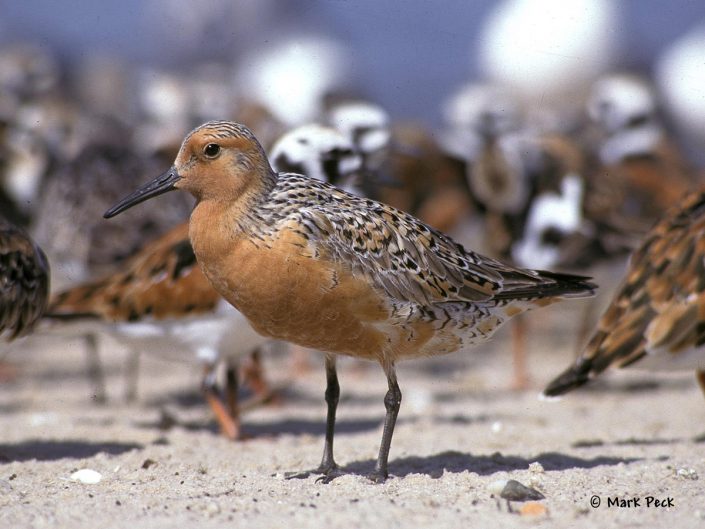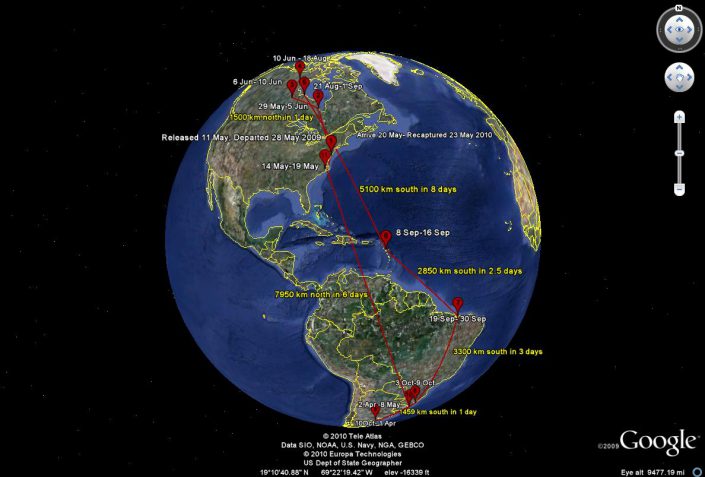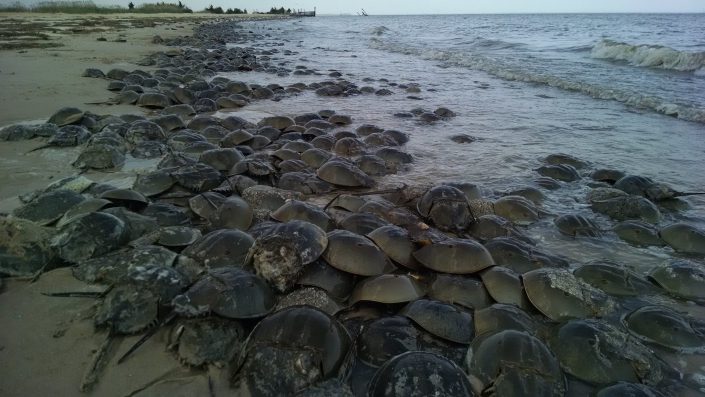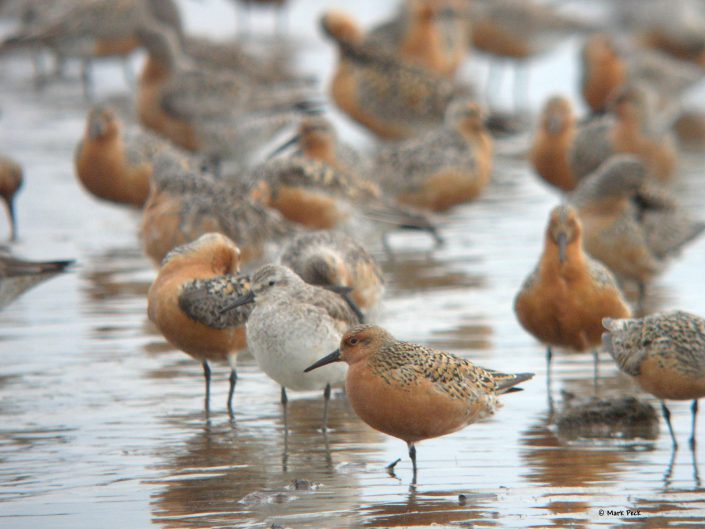International Migratory Bird Day Series: Red Knot
CWF is Celebrating International Migratory Bird Day all Week Long
by Lindsay McNamara, Communications Manager
CWF’s blog on the red knot is the third in a series of five to be posted this week in celebration of International Migratory Bird Day (IMBD). IMBD 2016 is Saturday, May 14. This #birdyear, we are honoring 100 years of the Migratory Bird Treaty. This landmark treat has protected nearly all migratory bird species in the U.S. and Canada for the last century.

The iconic red knots have returned to New Jersey! These famous, mid-sized shorebirds are state endangered and now federally threatened — the first bird ever listed under the Endangered Species Act with climate change cited as a “primary threat.”
Red knots are only 10 inches long but are among the world’s most extreme long distance flyers — traveling vast distances — some over 18,000 miles in the course of their annual migration from Tierra del Fuego, Argentina all the way up to the Canadian Arctic (and back again). During their trip, the red knots make a vital stop at New Jersey’s Delaware Bay.

Each spring in Delaware Bay, throughout the month of May, the largest concentration of horseshoe crabs in the world comes onshore to spawn. At the same time, tens of thousands of shorebirds arrive at the Bay, thin and spent from what has been a non-stop, four-day flight from South America. They are en route on a remarkable round-trip journey from southern wintering grounds to Arctic breeding territory, and Delaware Bay is their most critical stopover on this 8,000-mile trip. The shorebirds need to quickly double their weight to complete their migration north and breed successfully. To refuel at such capacities and in only a ten-day window, high-energy horseshoe crab eggs provide essential nourishment. In recent years, countless horseshoe crab eggs have been lost because of the devastating storms that swept away the beaches they depend on.
In the wake of Hurricane Sandy, Conserve Wildlife Foundation and American Littoral Society worked with the U.S. Fish and Wildlife Service, the New Jersey Division of Fish and Wildlife and the New Jersey Recovery Fund to remove 8,000 tons of debris and added 45,000 tons of sand to the beaches just before the annual spring arrival of the red knot in 2013. Additional work after 2012 restored another mile of shoreline, including two new beaches of poor quality even before Sandy. To date, the groups have placed over 85,000 cubic yards of sand and restored seven beaches along New Jersey’s Delaware Bayshore.
To restore one of the beaches, Thompsons Beach, our team removed debris from the area, removed rubble from the road leading to the beach, and placed over 40,000 cubic yards of sand onto the beach. We were delighted to learn that in the spring of 2015, Thompsons Beach had the highest abundance of horseshoe crab egg clusters out of all the beaches that our team monitors on Delaware Bay.

But since the early 1990s, there have been major declines in both the number of adult horseshoe crabs and their eggs. The cause is an exploding crab harvest that grew from only tens of thousands in 1990 to over 2 million in 1996. With the decline of their critical food source, shorebird numbers also plummeted — the Delaware Bay shorebird populations remain around 26% of its historic population size. Over 25,500 red knots were seen in 2015 versus over 90,000 in 1989.
Conserve Wildlife Foundation and the Endangered and Nongame Species Program (ENSP) of the New Jersey Department of Environmental Protection’s Division of Fish & Wildlife have partnered for 20 years, working to conduct research on Delaware Bay shorebirds in order to prevent further decline. Each year, CWF’s Larry Niles and ENSP’s Amanda Dey lead a team of shorebird experts from around the world – from countries as far as Argentina and New Zealand – to conduct research on shorebirds during their stopover. These experts also follow shorebirds to other locations along their migration, including South America and the Arctic. With scientific research and concerted conservation efforts, our hopes are that someday Delaware Bay’s skies will be once again filled with shorebirds.

Last year, nearly every red knot left the bay in good condition, with over 77% reaching weights exceeding 180 grams, the threshold weight required for a successful flight to the Arctic breeding areas. The improvement in the number of red knots reaching 180 grams is a milestone for our shorebird project. The birds left in the best condition recorded since 1998, just as horseshoe crabs were being overharvested. This good news must be tempered by the continued low numbers of birds and horseshoe crabs. We report no improvement in horseshoe crab numbers, so the improvement in the number of red knots making weight is likely a consequence of the restoration of horseshoe crab habitat on Delaware Bay beaches.
Because shorebirds don’t only spend their time in Delaware Bay, shorebird scientists must study them throughout the Atlantic Flyway to get the best understanding of their unique ecology. This year, shorebird project team was awarded a 2-year grant to create detailed shorebird habitat maps in the states of Maranhão and Pará, Brazil. This project will set the foundation for conservation planning and action for decades to come at a shorebird wintering site of hemispheric importance that has received little conservation and research attention with regard to shorebirds thus far.
Over the last 6 years, CWF also has partnered with the USFWS Monomoy Refuge to develop a better understanding of migratory shorebird use on Cape Cod and at the Refuge. Cape Cod, like Stone Harbor and Brigantine, New Jersey, is an important southbound stopover for red knots. At each location, red knots come from their Arctic breeding areas and either build up weight for a flight to South America, or remain to molt and replace vital primary feathers before moving onto shorter distance wintering areas in Florida and Cuba.

Another important piece of CWF’s shorebird research has been the attachment and recovery of geolocators, small devices that track movements through one to two years of battery life. The migratory tracks from recovered geolocators have greatly expanded our understanding of red knot migratory behavior. In CWF’s last two years of research, we focused on capturing juveniles, which move through the Cape in early September. Red knot juvenile #254 was a recapture two years after release on Delaware Bay. It first left Cape Cod and wintered in North Carolina. In their first year, juvenile red knots don’t go to the Arctic to breed and so #254 flew back to Cape Cod to summer. The following fall, it flew to Cuba to winter, then to North Carolina, then to the Arctic. This was the first known track of a juvenile red knot and one of only a few of any avian species! CWF is continuing our geolocator project this year, so follow along on our blog and social media channels to receive updates on cutting-edge red knot research!
Learn More:
- Conserve Wildlife Foundation’s Delaware Bay Shorebird Project
- Conserve Wildlife Foundation’s online field guide: Red Knot
Lindsay McNamara is the Communications Manager for Conserve Wildlife Foundation of New Jersey.
Discover more from Conserve Wildlife Foundation of NJ
Subscribe to get the latest posts sent to your email.